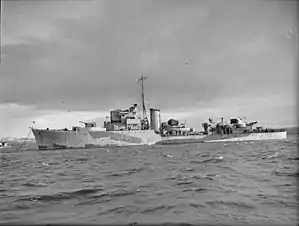French destroyer La Combattante
La Combattante ("The Combatant") was a destroyer[1] of the Forces navales françaises libres (FNFL). A British-built Hunt-class destroyer, she was offered to the Free French in 1942.
 La Combattante in January 1943 | |
| History | |
|---|---|
| Name | HMS Haldon |
| Builder | Fairfield Shipbuilding and Engineering Company, Glasgow |
| Laid down | 16 January 1941 |
| Launched | 27 April 1942 |
| Completed | 30 December 1942 |
| Identification | Pennant number: L19 |
| Fate | Transferred to Free French Navy in 1942 |
| Name | La Combattante |
| Acquired | 1 December 1942 |
| Commissioned | 15 December 1942 |
| Fate | Mined 23 February 1945 |
| General characteristics | |
| Class and type | Type III Hunt-class destroyer |
| Displacement | 1,050 tons standard; 1,435 tons full load |
| Length | 85.3 m (280 ft) |
| Beam | 10.16 m (33.3 ft) |
| Draught | 3.51 m (11.5 ft) |
| Propulsion | 2 Admiralty 3-drum boilers, 2 shaft Parsons geared turbines, 19,000 shp (14,000 kW) |
| Speed | 27 knots (50 km/h; 31 mph) |
| Range | 2,350 nmi (4,350 km) at 20 knots (37 km/h) |
| Complement | 168 |
| Electronic warfare & decoys |
|
| Armament |
|
History
Laid down as HMS Haldon, she was damaged in a bombing in the night of 14 March 1941. She was offered to the FNFL in 1942, and renamed La Combattante.
Escort duty and S-Boot fighting
La Combattante made her first sortie in 23 March 1943, escorting a convoy in the English Channel. She rescued 68 sailors from the liberty ship Stell Traveller, after it had struck a mine.
On 29 May 1943, she rescued British and Australian aircrews ; in September 1943, she rescued two British airmen.
In the night of 25–26 April 1944, La Combattante and the frigate HMS Rowley intercepted a group of German E-boats; La Combattante managed to sink S-147 and damage another ship. In the night of 12–13 May, La Combattante destroyed S-141, killing Klaus Dönitz, Admiral Dönitz's son in the process.
During the night of 27–28 May La Combattante met motor torpedo boats MTB-732 and MTB-739; the two groups mistakenly engaged each other, and MTB-732 was sunk.
D-Day
Under commandant André Patou, La Combattante took part in Operation Neptune, providing close fire support to the landing parties during the Battle of Normandy off Courseulles-sur-Mer. She stayed 3,000 metres (9,800 ft) off the beach, in 4 metres (13 ft) deep waters, as she shelled shore batteries; at one point she ran aground, and HMS Venus morsed "I am happy that a French be the first to touch the ground of France". La Combattante destroyed several shore batteries, until troops started landing on the beach. She then returned to Portsmouth, escorting a landing ship dock.
On 25 June 1944 La Combattante rescued two downed US pilots.
Ferrying General De Gaulle
La Combattante kept escorting convoys in the Channel between France and England until 14 July 1944, when she was ordered to the King's Stairs of Portsmouth harbour; awaiting the ship's arrival were General Charles de Gaulle, Generals Béthouart and Koenig, Admiral d'Argenlieu, Gaston Palewski, Pierre Viénot, Pierre Billotte, François Coulet, Pierre de Chevigné, Geoffroy de Courcel, Pierre Laroque and Claude Hettier de Boislambert, preparing to cross the English Channel to Normandy[2] The delegation also carried a 250-million franc treasure to counter introduction of the US occupation franc. One of the most famous photographs of De Gaulle was taken aboard during the journey,[3] before he landed at Courseulles.[4]
Fights off Normandy
La Combattante further patrolled the Channel. In the night of 25–26 August 1944, she sank four German ships ferrying an artillery unit.
On 23 February 1945, an explosion broke La Combattante in two and she sank quickly, with 117 survivors of her 181-man crew. Allied sources stated the ship having been sunk whilst running on a mine. On the German side, a Kriegsmarine bulletin reported that La Combattante was destroyed at 10.28 a.m. on 24 February by two torpedoes fired by U-5330, a German midget submarine of the Seehund type commanded by lieutenant Klaus Sparbrodt, approximately 8 kilometres (5.0 mi) off the South-Fall Bank. Sparbrodt was decorated for his alleged success. The ship sunk by Sparbrodt was in fact the British cable layer CS Alert.[5]
Notes and references
- Designed as "torpilleur", literally "torpedo ship"
- It seems that the proper orders had not been given, which resulted in the following conversation:
— Commandant Patou: I assume you wish to go to France, General ?
— General de Gaulle: Did you not receive your orders ?
— Patou: No General, but it does not matter, we already know the way.
— Admiral d'Argenlieu: Off to Normandy! Archived 6 February 2012 at the Wayback Machine - photograph aboard La Combattante
- AFP
- "Midget submarine operations". uboat.net. Retrieved 19 September 2015.
Publications
- Colledge, J. J.; Warlow, Ben (2006) [1969]. Ships of the Royal Navy: The Complete Record of all Fighting Ships of the Royal Navy (Rev. ed.). London: Chatham Publishing. ISBN 978-1-86176-281-8.
- English, John (1987). The Hunts: a history of the design, development and careers of the 86 destroyers of this class built for the Royal and Allied Navies during World War II. England: World Ship Society. ISBN 0-905617-44-4.